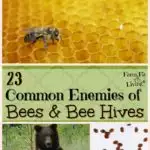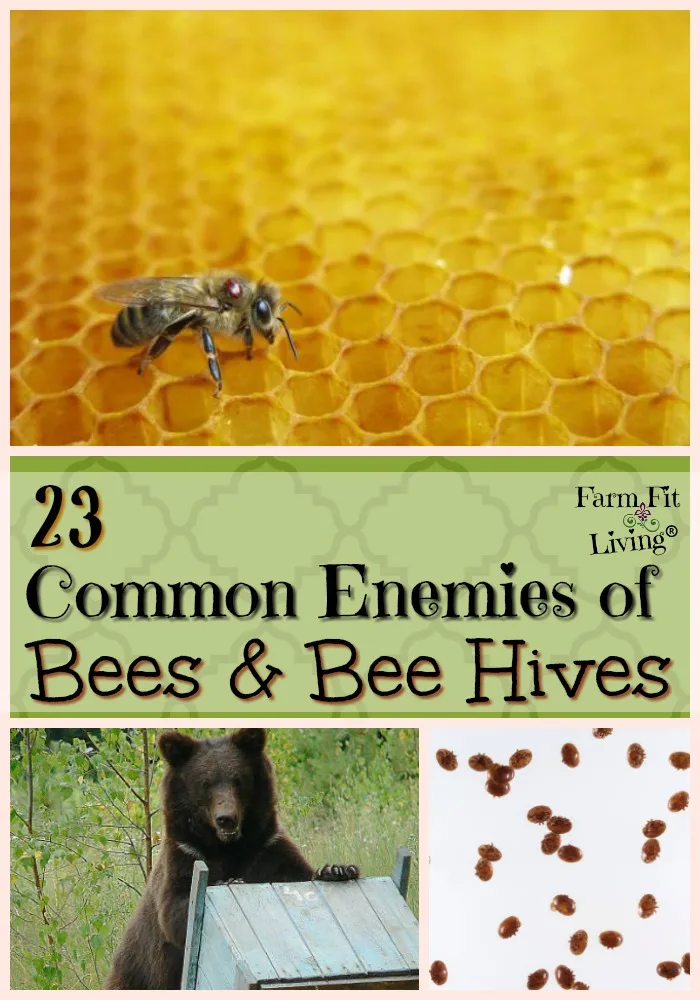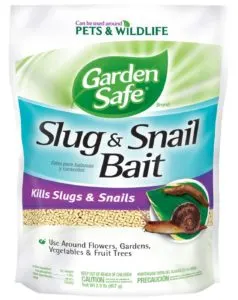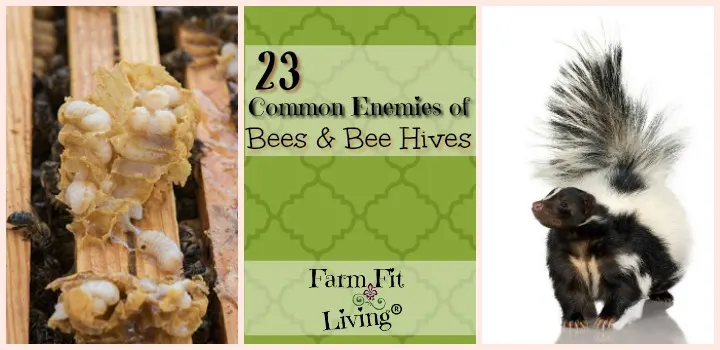Are you aware of these common enemies of honey bees??
A lot of times, we beekeepers have no idea what made our bees leave or what happened to the hives. I put together this list of common enemies of honey bees and beehives with some possible answers to your questions.
In this post, I will:
- Uncover 23 of the most common live enemies of honey bees.
- Describe some methods from preparing and protecting bee hives from bee predators.
- Some great bee information for kids and adults interested in keeping bees.
Listen to the Podcast:
This post contains Affiliate Links. This means if you click and buy, I might make a commission at no cost to you.
See my policy for more information
Wax Moths
When bee hives grow weak, the wax moths come in.
With the guard bee population weak or lowered, the moths have an easier time of laying their eggs in cracks between hive parts. After they hatch, the damage is done. They tunnel into wax combs and just make a huge mess with their cocoons. You’ll see the cocoons attached to the wooden parts of equipment, their silk trails, and damaged combs all throughout the hive.
Controlling wax moths is not that hard:
- Keep colonies strong.
- Freeze frames and combs for a few days.
- Store empty combs with moth balls.
- Let the chickens clean up the larvae in the frames – They love this treat.
- Using fire ants to kill wax moths.
Read more about controlling wax moths here
Small Hive Beetle are Common Enemies of Honey Bees
This enemy is a small reddish brown or black beetle covered in fine hair. The larvae is commonly confused with a young wax moth larvae. Beetle larve is different because they have three sets of legs behind the head, where wax moth larvvae have three sets of legs plus a series of paired prolegs all along the body.
Here’s what they do in the hive:
- Eat pollen, wax, honey, bee eggs and larvae.
- Poop in the honey, causing it to ferment.
- Cause Queens to stop laying eggs. This will eventually result in weak hives.
How to know if you have these beetles:
- You can see them in the hives running around.
- Larvae on the combs and bottom board.
- Fermented honey.
Ways to control them:
- Maintain strong colonies.
- Keep hives clean of all equipment.
- Extract honey as soon as it is removed from colonies.
- Destroy beetles using the following products:
Slug & Snail Pellets
These pellets are simple to use and works great for beetle larvae that burrows into the ground. Sprinkle this around the base of your hives to help control larvae from coming to the entrance to your hives.
Apivar Miticide Strips
The miticide strips kill 99.9% of mites and larvae in a 6 week period.
I’ll have a special post JUST for controlling Small Hive Beetle Soon
Mites
One of the most common parasites of bees. They have been known to be the bees worst enemy. And there’s so much information and so many different ways to treat mites. I just can’t fit it all into this post when I’m trying to mention all of the common enemies of honey bees.
Here are the two major types of mites that affect honey bees.
- Varroa – Attach themselves to the outside of adult bees.
- Tracheal – Lives inside the breathing organs of bees.
And there’s so much information about these mites because they have became a huge problem over the years! I plan to write more informative posts breaking down the information and my experiences for you in the future.
I’ll have posts just for controlling these mites soon!
For now, I’ll summarize briefly how I’m testing for each mite:
Varroa
Varroa mites you can see. Look for Disfigured or stunted bees or pale and dark reddish brown spots.
There are three main ways to test for varroa. None of them are easy on the bees but they are necessary.
The first is to pick up a frame of brood. Scratch the pupae out of the comb and examine. You should see at least 2 mites per cell.
The second is the ether roll. Collect bees in a jar. Then, cover the bees with ether starter fluid and then shake the jar. This dislodges the mites from the bees and then roll the jar around for 10 minutes. The mites will stick to the side of the jar.
The third way is to use tobacco smoke and a sticky board in the bottom of the colony. The sticky board is just a board coated with Vaseline. Smoke the colony about 6-10 times and then close up the hive for 20 minutes. This will cause the mites to fall off and land on the sticky board. You can then count the mites on your board and then treat accordingly.
Tracheal Mites
You cannot see these mites, so you have to kill bees and dissect them. Collect older bees. Place them in a 70% ethyl alcohol or rubbing alcohol solution. You can also freeze them in a glass jar.
Then, deliver them to a state insect inspector if you have one. Find this person through your Extension Office.
Or you can dissect them yourself. I’ll have a post on this topic as well, in the near future. (There’s only so much time in the day!)
The bees can then be examined and dissected to see if they contain Tracheal mites.
Again – This is a very brief summary.
I will soon be posting more on this topic of bee parasites as time allows.
A quick word on treatment: Keeping your hives strong and healthy is the best management practice. However, treatments can include the Miticide strips above and also Oxylic Acid. These are the two best varroa mite treatment options.
For more info on treating for mites in the Fall , go here.
Ants
Ants can be a serious problem in some places. These include:
- Carpenter Ants
- Fire Ants
- Argentine Ants
Here’s how you can keep ants from becoming a problem:
- Keep weeds down
- Get rid of debris and rotted wood.
- Ant control around the base of the hive.
- Painting the base of the hive with oil.
While these are minor enemies of bees, it’s still not a bad idea to be proactive and in control of ants by doing a few of the items on this list.
Robber Bees
The best way to prevent robber bees from coming into your hives is to be smart about how you feed hives. Avoid placing bee food right outside the hives or on top of the hives.
This can prevent the robber bees from sniffing out the hives.
Aggressive Bees
Africanized Honey bees are still types of honey bees that can be dangerous to you…and to your honey bees.
If you live in the southern states (Texas, Arizona, etc), you might have already been dealing with these. How do you know?
Here’s some 5 facts about bees that are Africanized:
- Smaller than the gentle European Breeds of Honey Bees
- Faster Moving
- Aggressive
- More apt to swarm
- More apt to invade a gentle colony, making them common enemies of honey bees.
There are many beekeepers out there who keep the Africanized honey bees. However, there are also keepers do not, but find their bees have became more aggressive . It is a possibility that a swarm of Africanized honey bees with a queen could have forced themselves into a hive with a gentle Queen, killed her and then the Africanized Queen took over.
Therefore, keeping track of your hive with hive inspections and searching for your original Queen is important to solving this theory.
Need a hive inspection sheet? Snag mine here for instant download.
Skunks/Raccoons
Did you know that skunks eat bees? Yes, it’s true but they can also cause extensive damage to equipment. They also dig up the bee yard around the hives looking for food.
Skunks are super sneaky in the way they lure the bees to come out of the hives. Their method is to scratch at the entrance. As the bees crawl out, the skunks can easily catch and enjoy them as a snack.
Raccoons can also be very destructive, throwing around equipment, such as feeders and frames of honey that have been left out.
Here’s some ways for controlling these common enemies of honey bees:
- Set your hives up at least 18 inches off the ground. This keeps skunks from reaching the entrance.
- Rock salt crystals on the ground around the hives will help keep vegetation from growing up around the hive.
- Live trapping these animals are a good way to take control.
- Contact your local wildlife agent to try to locate a nest and destroy or move them away from the area.
Like any other rodent, raccoons and skunks need to be controlled as soon as possible because they reproduce quickly. Here’s another mammal predator that is not so easy to deter from your bee hives.
Bears
If you’ve ever watched or read Winnie the Pooh, you know that bears love honey.
However, real bears are not like Pooh Bear. They don’t just stick their paw in, grab some honey and go on with life.
They mutilate bee hives and can cause real damage. I’ve seen many pictures from beekeepers where bears have destroyed hives.
Here’s what that looks like:
- Overturned Hives
- Smashed Hive Bodies
- Scattered Frames
- Stolen Supers
If you know bears and their movements, you could try to keep hives away from those locations. Of course, it’s not always long-term since the bears can smell the honey and will be attracted to it no matter where it’s located.
A high-tensile electric fence around the hive yard can help deter bears away from the hive yard.
Mice & Other Rodents
Mice are one of the most damaging animals to bee hives. Just like our homes, they tend to come into hives in the Fall.
Here’s what they can do to a hive:
- Cause extensive damage to comb.
- Destroy wooden wires
- Eat the pollen, honey, larvae, brood, and even the bees!
- Pee and poop every where, leaving a big irritation to the hive colony.
This is why it’s also important to keep mice out of your hive storage room. They are so destructive and easily preventable with a few different strategies:
If you want to control mice getting into your storage room, check out this post
There is this thing called the mouse guard that you can put in the bee hive entrances in the Fall.
Mouse Guard
This is the length for a 10-frame Langstroth hive. You can also get sizes easily for 8-frame hives as well. Place it in the entrance.
Robbing & Vandalizing Humans
Unfortunately, I’ve seen way too many posts on social media about bee hives that have been vandalized or robbed by other human beings. This is inhumane and uncalled for.
It’s actually the BIGGEST common enemies of bees, which is so disheartening.
The main reason humans decide to rob or destroy bee hives is generally unknown, but here are a few possible reasons:
- Demands of equipment – They need a piece but don’t want to buy it.
- Stealing honey.
- Mischief
- Revenge
The truth is that you can’t always control other people’s actions.
BUT you can control how you react to this unfortunate situation:
- Placing hives near your home or a place where people are most of the time.
- Branding your hives in some way to find them if they are stolen.
- Put a locked fence up around bee yard.
- Camo-flauge your hive with a different color other than white.
Other Insects:
- Assasin Bugs
- Flies
- Mantids
- Hornets
- Dragonflies
- Fruit Moths
- Scarab Beetle
These are all pretty minor and especially not a problem for a strong hive. Yet another reason to keep bee hives as strong as possible.
Birds
Some birds like to eat bees. These include:
- Flycatchers
- Kingbirds
Also, woodpeckers are notorious for damaging equipment. However, there’s not a lot you can do about birds since just killing them is basically illegal.
My advice is to contact your wildlife control agent if you’re having a problem with birds destroying your equipment and your bee populations.
Livestock
Cattle, sheep, goats and pigs might think that hives are toys. They can playfully rub or jump on hive and cause a big problem if the bees are disturbed.
I personally have one of my bee yards in the pasture where my livestock is. We put a fence up all the way around it and that keeps the livestock out easily.
Frogs, Toads & Lizards
These are very minor honey bees enemies but are also known to be bee eaters.
Usually having snakes or other beneficial wildlife can help keep control of these small enemies.
Prepare Yourself for Beekeeping Success by knowing the Common Enemies of Honey Bees
Now you are aware of some common enemies of honey bees that you might not have thought about before. You can be more proactive in the location of your hive yard as well as preventative practices to keep these common bee predators away.
Happy Beekeeping!









How to Move Bees Safely from One Place to Another
Wednesday 19th of December 2018
[…] If you’re wondering about the well being of your hives, check out this post… […]